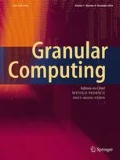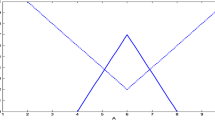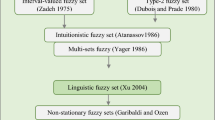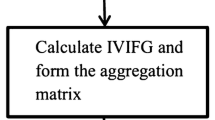Abstract
This paper develops fuzzy multi-criteria decision making (MCDM) approach to evaluate performance of airports according to the passengers’ perspective. Assessments for qualitative measures and quantitative measures are represented by intuitionistic cubic fuzzy numbers (ICFNs), and crisp numbers represents criteria weights, which are obtained via surveys. To construct a strategy for solving MCDM problems, we have developed extended forms of VIKOR method and TOPSIS method for ICFNs and constructed ICF-VIKOR and ICF-TOPSIS algorithm under ICF information in group decision environment. We have applied these methods for an experimental analysis of 7 significant international airports in the Asia-Pacific region to evaluate their performance with conflicting criteria under ICF environment. To show the supremacy of the proposed techniques, we have presented comparative analysis with the existing techniques.
Similar content being viewed by others
References
Ashraf S, Abdullah S, Mahmood T, Aslam M (2019a) Cleaner production evaluation in gold mines using novel distance measure method with cubic picture fuzzy numbers. Int J Fuzzy Syst 21(8):2448–61
Ashraf S, Abdullah S, Mahmood T, Ghani F, Mahmood T (2019b) Spherical fuzzy sets and their applications in multi-attribute decision making problems. J Intell Fuzzy Syst 36(3):2829–44
Ashraf S, Abdullah S, Muneeza (2020) Some novel aggregation operators for cubic picture fuzzy information: application in multi-attribute decision support problem. Granul Comput 21:1–6
Atanassov KT (1986) Intuitionistic fuzzy sets. Fuzzy Sets Syst 20:87–96
Atanassov KT (1986) Intuitionistic fuzzy sets. Physica, Heidelberg, pp 1–137
Chen SM (1996) A fuzzy reasoning approach for rule-based systems based on fuzzy logics. IEEE Trans Syst Man Cybern Part B 26(5):769–778
Chen SM, Chang CH (2016) Fuzzy multiattribute decision making based on transformation techniques of intuitionistic fuzzy values and intuitionistic fuzzy geometric averaging operators. Inform Sci 352:133–149
Chen SM, Huang CM (2003) Generating weighted fuzzy rules from relational database systems for estimating null values using genetic algorithms. IEEE Trans Fuzzy Syst 11(4):495–506
Chen SM, Jong WT (1997) Fuzzy query translation for relational database systems. IEEE Trans Syst Man Cybern Part B 27(4):714–721
Chen SM, Randyanto Y (2013) A novel similarity measure between intuitionistic fuzzy sets and its applications. Int J Pattern Recognit Artif Intell 27(07):1350021
Chen SM, Randyanto Y, Cheng SH (2016) Fuzzy queries processing based on intuitionistic fuzzy social relational networks. Inform Sci 327:110–124
Fahmi A, Abdullah S, Amin F (2018) Expected values of aggregation operators on cubic trapezoidal fuzzy number and its application to multi-criteria decision making problems. J New Theory 22:51–65
Fahmi A, Abdullah S, Amin F, Khan MSA (2019) Trapezoidal cubic fuzzy number Einstein hybrid weighted averaging operators and its application to decision making. Soft Comput 23(14):5753–5783
Garg H, Kumar K (2020) A novel exponential distance and its based TOPSIS method for interval-valued intuitionistic fuzzy sets using connection number of SPA theory. Artif Intell Rev 53(1):595–624
Garg H, Rani D (2019) Some generalized complex intuitionistic fuzzy aggregation operators and their application to multicriteria decision-making process. Arab J Sci Eng 44(3):2679–98
Guzha ED, Khvostova TV, Romanenko VA, Skorokhod MA (2020) Fuzzy multiple regression technical and economic model of airport terminal passenger handling system. IOP Conf Ser 734(1):012113
Hashemi H, Mousavi SM, Zavadskas EK, Chalekaee A, Turskis Z (2018) A new group decision model based on grey-intuitionistic fuzzy-ELECTRE and VIKOR for contractor assessment problem. Sustainability 10(5):1635
Hwang CL, Masud AS (2012) Multiple objective decision making–methods and applications: a state-of-the-art survey. Springer Science and Business Media, Berlin
Hwang CL, Yoon K (1981) Methods for multiple attribute decision making. In: Multiple attribute decision making. Springer, Berlin, Heidelberg, pp 58–191
Ighravwe DE, Oke SA (2020) Sustenance of zero-loss on production lines using Kobetsu Kaizen of TPM with hybrid models. Total Qual Manag Bus Excell 31(1–2):112–136
Jahanshahloo GR, Lotfi FH, Izadikhah M (2006) An algorithmic method to extend TOPSIS for decision-making problems with interval data. Appl Math Comput 175(2):1375–84
Jana C, Senapati T, Pal M, Yager RR (2019) Picture fuzzy Dombi aggregation operators: application to MADM process. Appl Soft Comput 74:99–109
Jun YB, Kim CS, Yang KO (2011) Annals of fuzzy mathematics and informatics. Cubic Sets 4(1):83–98
Kumar PS (2020) Intuitionistic fuzzy zero point method for solving type-2 intuitionistic fuzzy transportation problem. Int J Oper Res 37(3):418–51
Kumar A, Aswin A, Gupta H (2020) Evaluating green performance of the airports using hybrid BWM and VIKOR methodology. Tour Manag 76:103941
Li DF (2010) TOPSIS-based nonlinear-programming methodology for multiattribute decision making with interval-valued intuitionistic fuzzy sets. IEEE Trans Fuzzy Syst 18(2):299–311
Li H, Wang W, Fan L, Li Q, Chen X (2020) A novel hybrid MCDM model for machine tool selection using fuzzy DEMATEL, entropy weighting and later defuzzification VIKOR. Appl Soft Comput 91:106207
Liao H, Xu Z (2013) A VIKOR-based method for hesitant fuzzy multi-criteria decision making. Fuzzy Optim Decis Mak 12(4):373–92
Loh HS, Yuen KF, Wang X, Surucu-Balci E, Balci G, Zhou Q (2020) Airport selection criteria of low-cost carriers: a fuzzy analytical hierarchy process. J Air Transp Manag 83:101759
Luo X, Wang X (2017) Extended VIKOR method for intuitionistic fuzzy multiattribute decision-making based on a new distance measure. Math Probl Eng. https://doi.org/10.1155/2017/4072486
Mahtani US, Garg CP (2018) An analysis of key factors of financial distress in airline companies in India using fuzzy AHP framework. Transp Res Part A 117:87–102
Manoj TV, Leena J, Soney RB (1998) Knowledge representation using fuzzy Petri nets-revisited. IEEE Trans Knowl Data Eng 10(4):666–7
Mareschal B, Brans JP, Vincke P (1984) PROMETHEE: a new family of outranking methods in multicriteria analysis. ULB-Universite Libre de Bruxelles, Bruxelles
Muneeza, Abdullah S (2020) Multicriteria group decision-making for supplier selection based on intuitionistic cubic fuzzy aggregation operators. Int J Fuzzy Syst 22:810–823
Muneeza, Abdullah S, Aslam M (2020) New multicriteria group decision support systems for small hydropower plant locations selection based on intuitionistic cubic fuzzy aggregation information. Int J Intell Syst 35(6):983–1020
Nazam M, Yao L, Hashim M, Baig SA, Khan MK (2020) The application of a multi-attribute group decision making model based on linguistic extended VIKOR for quantifying risks in a supply chain under a fuzzy environment. Int J Inf Syst Supply Chain Manag (IJISSCM) 13(2):27–46
Olfat L, Amiri M, Soufi JB, Pishdar M (2016) A dynamic network efficiency measurement of airports performance considering sustainable development concept: A fuzzy dynamic network-DEA approach. J Air Transp Manag 57:272–90
Opricovic S (1998) Multicriteria optimization of civil engineering systems. Fac Civil Eng Belgrade 2(1):5–21
Opricovic S, Tzeng GH (2003) Fuzzy multicriteria model for postearthquake land-use planning. Natl Hazards Rev 4(2):59–64
Opricovic S, Tzeng GH (2004) Compromise solution by MCDM methods: a comparative analysis of VIKOR and TOPSIS. Eur J Oper Res 156(2):445–55
Pandey MM (2016) Evaluating the service quality of airports in Thailand using fuzzy multi-criteria decision making method. J Air Transp Manag 57:241–9
Paraschi EP, Georgopoulos A, Papatheodorou A (2020) Abiotic determinants of airport performance: insights from a global survey. Transp Policy 85:33–53
Park JH, Cho HJ, Kwun YC (2011) Extension of the VIKOR method for group decision making with interval-valued intuitionistic fuzzy information. Fuzzy Optim Decis Mak 10(3):233–253
Pishdar M, Ghasemzadeh F, Antuchevičienė J (2019) A mixed interval type-2 fuzzy best-worst MACBETH approach to choose hub airport in developing countries: case of Iranian passenger airports. Transport 34(6):639–51
Qiyas M, Abdullah S, Muneeza (2020a) A novel approach of linguistic intuitionistic cubic hesitant variables and their application in decision making. Granul Comput. https://doi.org/10.1007/s41066-020-00225-3
Qiyas M, Abdullah S, Liu Y, Naeem M (2020b) Multi-criteria decision support systems based on linguistic intuitionistic cubic fuzzy aggregation operators. J Ambient Intell Humaniz Comput. https://doi.org/10.1007/s12652-020-02563-1
Riaz M, Tehrim ST (2019) Cubic bipolar fuzzy ordered weighted geometric aggregation operators and their application using internal and external cubic bipolar fuzzy data. Comput Appl Math 38(2):1–25
Rouyendegh BD, Yildizbasi A, Üstünyer P (2020) Intuitionistic fuzzy TOPSIS method for green supplier selection problem. Soft Comput 24(3):2215–28
Shojaei P, Haeri SA, Mohammadi S (2018) Airports evaluation and ranking model using Taguchi loss function, best-worst method and VIKOR technique. J Air Transp Manag 68:4–13
Skorupski J, Uchroński P (2018) Evaluation of the effectiveness of an airport passenger and baggage security screening system. J Air Transp Manag 66:53–64
Sun B, Wei M, Wu W, Jing B (2020) A novel group decision making method for airport operational risk management. Math Biosci Eng 17:2402–17
Vahdani B, Hadipour H, Sadaghiani JS, Amiri M (2010) Extension of VIKOR method based on interval-valued fuzzy sets. Int Adv Manuf Technol 47(9–12):1231–1239
Wan SP, Wang QY, Dong JY (2013) The extended VIKOR method for multi-attribute group decision making with triangular intuitionistic fuzzy numbers. Knowl Based Syst 52:65–77
Yildirim BF, Mercangoz BA (2020) Evaluating the logistics performance of OECD countries by using fuzzy AHP and ARAS-G. Eurasian Econ Rev 10(1):27–45
Yu B, Guo Z, Asian S, Wang H, Chen G (2019) Flight delay prediction for commercial air transport: a deep learning approach. Transp Rese Part E 125:203–21
Zadeh LA (1965) Fuzzy sets. Inf Control 8(3):338–353
Zeng S, Chen SM, Kuo LW (2019) Multiattribute decision making based on novel score function of intuitionistic fuzzy values and modified VIKOR method. Inf Sci 488:76–92
Zhang H, Zhang R, Huang H, Wang J (2018) Some picture fuzzy Dombi Heronian mean operators with their application to multi-attribute decision-making. Symmetry 10(11):593
Zhao H, Xu Z, Ni M, Liu S (2010) Generalized aggregation operators for intuitionistic fuzzy sets. Int J Intell Syst 25(1):1–30
Zhou L, Tao Z, Chen H, Liu J (2014) Continuous interval-valued intuitionistic fuzzy aggregation operators and their applications to group decision making. Appl Math Model 38(7–8):2190–2205
Zou XY, Chen SM, Fan KY (2020) Multiple attribute decision making using improved intuitionistic fuzzy weighted geometric operators of intuitionistic fuzzy values. Inf Sci 535:242–53
Acknowledgements
This research work was supported by Higher Education Commission (HEC) under National Research Programme for University (NRPU), Project title, Fuzzy Mathematical Modelling for Decision Support Systems and Smart Grid Systems (No. 10701/KPK/NRPU/R&D/HEC/2017), Therefore the author grateful to NRPU, HEC.
Author information
Authors and Affiliations
Corresponding author
Ethics declarations
Conflict of Interest
The authors declared that they have no conflict of interest
Additional information
Publisher's Note
Springer Nature remains neutral with regard to jurisdictional claims in published maps and institutional affiliations.
Rights and permissions
About this article
Cite this article
Muneeza, Abdullah, S., Qiyas, M. et al. Multi-criteria decision making based on intuitionistic cubic fuzzy numbers. Granul. Comput. 7, 217–227 (2022). https://doi.org/10.1007/s41066-021-00261-7
Received:
Accepted:
Published:
Issue Date:
DOI: https://doi.org/10.1007/s41066-021-00261-7




